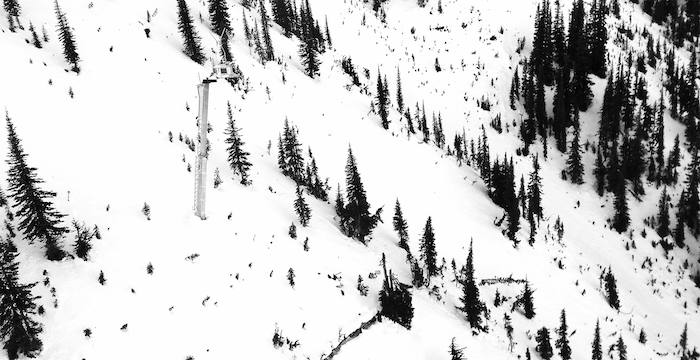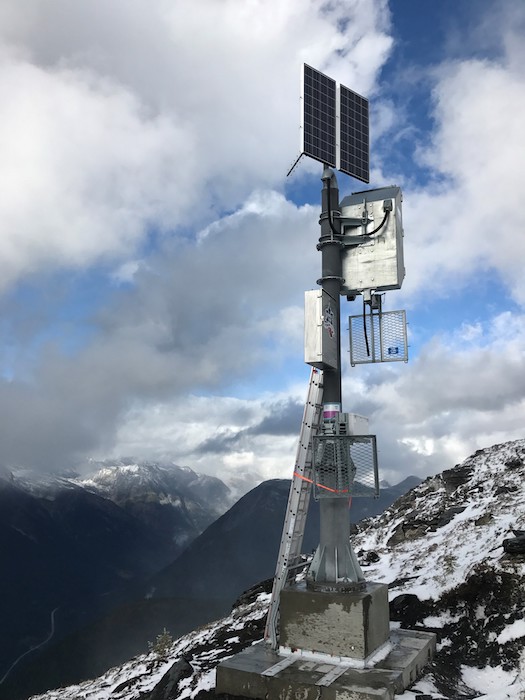
2021 #CCEawards Showcase: Trans-Canada Highway Avalanche Mitigation
November 18, 2021
By CCE
“An unprecedented, leading-edge showcase project that stands out for technical excellence and innovation." - Jury
Category: Special Projects
Schreyer Award and Award of Excellence Winner: McElhanney
Glacier National Park, located 650 km east of Vancouver, is home to a unique transportation corridor, combining the Trans-Canada Highway, Canadian Pacific Railway and a concentrated cluster of high-frequency avalanche paths. Parks Canada Agency engaged McElhanney to improve the corridor’s safety and reliability by implementing industry-leading avalanche mitigation measures.
These solutions, integrated with an existing, complex avalanche control program, have reduced risk for roadway users and the railway and will help keep Canadians moving year-round.
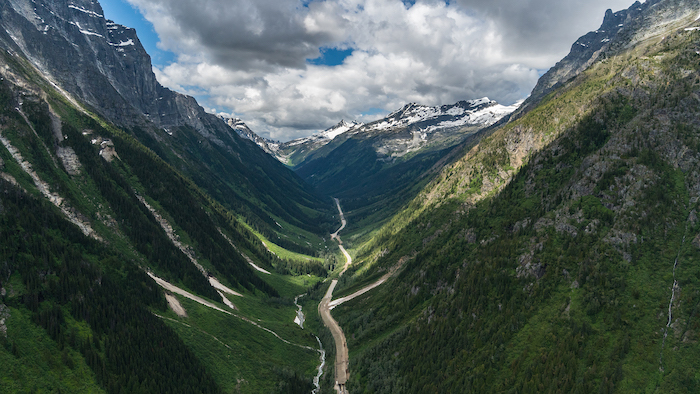
Rogers Pass is a transportation corridor amid a concentrated cluster of high-frequency avalanche paths.
An unprecedented system
Under Parks Canada Agency’s oversight, McElhanney—serving as prime consultant—partnered with Dynamic Avalanche Consulting to develop a new avalanche mitigation project along 43.8 km of the Trans-Canada Highway through Glacier National Park. The project began with an analysis of the existing avalanche program and identification of priority mitigations. The process also involved environmental and cultural resource considerations, unique procurement practices and construction management in challenging environments.
McElhanney and its partners planned, designed, prepared the tender for and oversaw the construction of 2 km of snow nets, which mitigate avalanches in three critical paths. There were no applicable North American design standards for these nets, so the team turned to Swiss guidelines.
The netting prevents snow in the start zone from releasing and causing an avalanche, thus removing the need for active control. These nets are now a leading example of how mitigation can be effective in challenging terrain on a large scale.
The team also managed the installation of 13 remote avalanche control systems (RACSs), which use explosives to initiate avalanches in five key paths. This arrangement eliminated the need for Parks Canada Agency and the Canadian Armed Forces to conduct artillery control at the park boundaries. Instead, the setup allowed for concurrent control of these paths with artillery control in other areas.
Further, McElhanney managed the design, tender and construction of a 19.5-m high reinforced earthen berm, specifically to reduce the likelihood of glide slab avalanches from reaching the highway and blocking the snow shed portal.
To assist in avalanche forecast decision-making, McElhanney investigated infrasound and Doppler radar technology. Infrasound arrays, which can detect the low-frequency soundwaves produced by avalanches, and Doppler radar systems, which can detect avalanches’ motion, had been previously used in small-scale installations, but never on the scale necessary for Glacier National Park.
First, McElhanney collaborated with Montana State University (MSU) and industry partners to develop a single infrasound array pilot program, which Parks Canada Agency forecasters confirmed and assisted in control and closure decisions. McElhanney then managed the procurement and calibration of a network of 13 overlapping infrasound arrays, along with four Doppler radar systems, resulting in the largest avalanche detection network (ADN) of its kind anywhere in the world.
This ADN allows forecasters to receive real-time alerts of avalanche activity, which helps them assess avalanche hazard, time road closures and select targets during artillery control. The network has advanced the industry’s use of this technology, by proving its capabilities at a scale and level of complexity never achieved before.
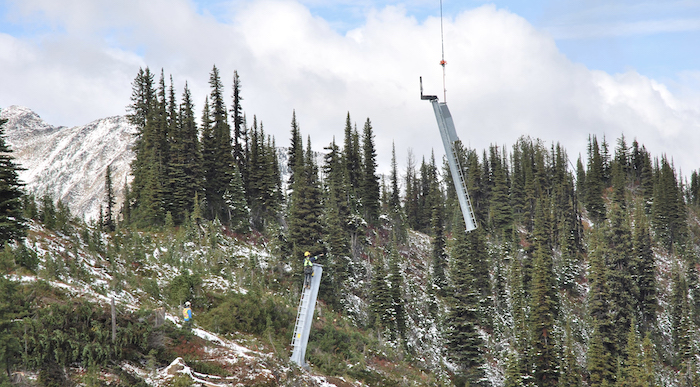
A remote avalanche control system (RACS) at the east end of the park helps increase the avalanche program’s efficiency.
A challenging environment
The sheer number of avalanche paths—135—that affect the roadway and railway through Glacier National Park makes it one of the most challenging transportation corridors in the world to implement and maintain an effective avalanche detection and mitigation program. The team’s proposals had to optimize Parks Canada Agency’s existing complex program, which involved numerous snow sheds, static defences and traffic ponding areas (i.e. to provide safe parking during avalanche control), separate highway and rail closure blocks and avalanche control using two mobile 105-mm Howitzer rifles firing at 270 targets from 16 overlapping gun positions.
The area is famous for its steep terrain and dense forests. The team’s access to remote areas to conduct their work was an ongoing challenge. McElhanney engaged certified mountain guides to escort its designers into some of the most exposed sites and field staff was trained in rope access. Some sites had to be searched for unexploded howitzer shells before any ground disturbance could occur.
McElhanney’s engineers relied on site reconnaissance and expertise with Light Detection and Ranging (LiDAR) mapping techniques and data during the design process. This was vital in anticipating and preventing measurement errors from the original assumed ground elevations. Construction costs remained within Parks Canada Agency’s expectations.
McElhanney completed more than 50 comprehensive site inspections during the design phase. The park’s very short summer season and extreme weather, coupled with the project’s timelines, meant there was no opportunity to recover delayed field work; the only option was to do it once and do it right.
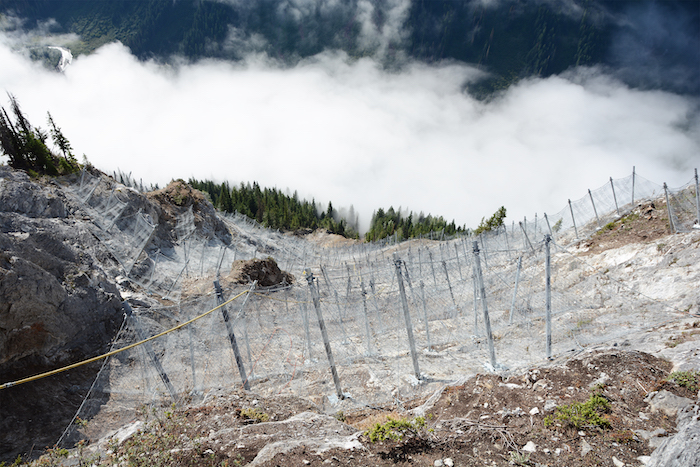
Nets were installed to prevent snow from releasing in start zones. This eliminated the need for avalanche control in these paths.
Getting unstuck
‘Revelstuck’ is the favoured phrase among locals in the Rogers Pass area to describe avalanche-related closures on the highway, as these affect people trying to travel through nearby Revelstoke, B.C. While some of them joke about how being trapped in a beautiful alpine town is a blessing, the economic impact of avalanche-related closures is significant.
McElhanney’s analysis concluded that approximately $24 billion worth of freight per year is transported along the highway between Alberta and British Columbia—and this does not include the value of freight passing via the railway, which also has a significant economic impact. Approximately $2.7 million worth of road freight passes through the avalanche corridor each hour. So, every minute of highway closure that can be prevented by the mitigation program represents a considerable economic benefit, while also making this vital link safer for everyone.
In addition to the freight-related benefits of the transportation corridor, it is important to recognize Glacier National Park attracts a large number of tourists to its pristine landscape and the Rogers Pass National Historic Site. They travel along the highway in private vehicles and tour buses and along the railway on-board the Rocky Mountaineer.
The area also attracts hikers, climbers, skiers and mountaineers, who all need a safe and reliable highway.
Protecting the environment
Glacier National Park was established in 1886 and is federally protected. McElhanney worked closely with Parks Canada Agency and various stakeholders to minimize visual impact and any potential disturbance to the natural landscape and wildlife throughout the corridor.
As such, McElhanney adopted the agency’s mandate for sustainability when developing its avalanche mitigation measures. In turn, the agency’s own environmental team developed environmental impact mitigations based on McElhanney’s design. These were further refined through collaboration between the teams as the design was finalized and further considerations were incorporated into construction contracts.
By way of example, McElhanney managed the contracts of 13 RACSs, 13 infrasound arrays and four Doppler radar systems powered by ‘green’ sources, including methanol fuel cells and solar panels. Further, the explosives detonated with the RACSs are biodegradable, so no long-term waste is introduced into the remote, mountainous environment.
McElhanney’s designs reused up to 200,000 m3 of local materials—such as landslide debris—as fill materials for the additional traffic ponding areas and the avalanche-stopping berm. The firm also oversaw the expansion of two major diversion berms at the Beaver River site to help protect the area from future landslide activity.
Glacier National Park is home to grizzly bears, wolverines, elk, owls and species-at-risk, such as caribou. McElhanney kept wildlife passages top-of-mind when developing systems. The snow nets, for example, feature regular openings to reduce intrusions into the natural routes along which wildlife may travel.
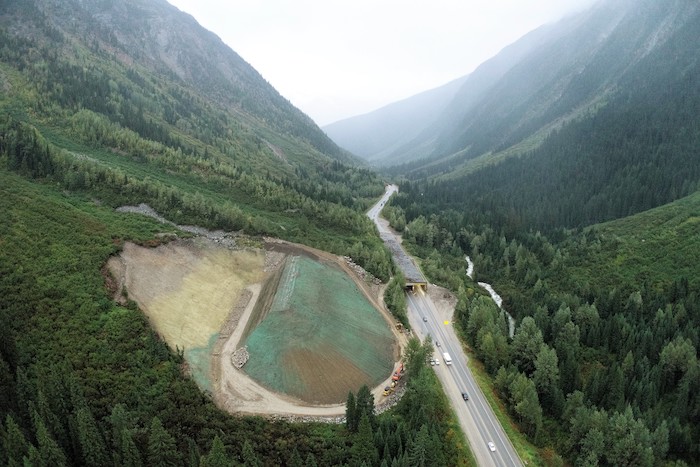
The 19.5-m high ‘Mounds’ berm reduces the likelihood of glide slab avalanches from reaching the highway and blocking the snow shed portal.
Saving time
Parks Canada Agency’s objectives included improving highway safety, winter highway reliability and avalanche program efficiency. To ensure all of these objectives were met, team members assessed, ranked and recommended specific mitigation options, before managing and undertaking planning, design, tender package preparation, construction supervision and contract management for the prioritized options.
The resulting suite of implemented solutions reduced the area’s avalanche hazard index by an estimated 21%, the average annual winter Trans-Canada Highway closure time by approximately seven hours and the average annual mobilization time for avalanche control by an estimated 14 hours.
The RACSs installed near Glacier National Park’s boundaries eliminated the need for artillery control in these areas, resulting in reductions to mobilization time and cost. By way of explanation, these areas are now controlled with RACSs, concurrent to artillery control in other areas of the park.
Further, the RACSs eliminated the need to close the highway to control some avalanches that only affect the railway, thus reducing overall closure time and the related impact on freight movement. The snow nets and stopping berm, further, eliminate the need for avalanche control and cleanup within their paths. And finally, the ADN improves the timing and control of closures along the highway by increasing support for the forecasters’ decision-making process.
Trans-Canada Highway Avalanche Mitigation, Rogers Pass National Historic Site, B.C.
Award-winning firm (prime consultant): McElhanney, Calgary (Naginder Jabbal, P.Eng., C.Eng., PMP; Alvin Hemmingson, C.Tech, RSIS; Jaime Sanderson, EIT; Richard Singer, P.Eng., PMP; Scott McTavish, CET; Jenny Lines, P.Eng.).
Owner: Parks Canada Agency.
Other key players: Dynamic Avalanche Consulting (avalanche modelling and design).
